Kinetics - The Collision Theory and Reaction Rates (A-Level Chemistry)
The Collision Theory and Reaction Rates
The Collision Theory
The collision theory states that for a reaction to occur, the particles involved must collide the right way round (with the correct orientation) and with enough energy so that the bonds are broken between the reactants.
Correct Orientation
Firstly, for a reaction to be successful, the particles need to collide in the correct orientation so that the correct bonds are broken or formed. The particles need to be moving towards in each other and facing each other so that the particles do not simply bounce off each other resulting in an unsuccessful collision.
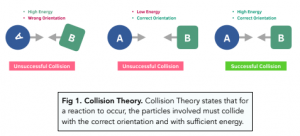
Activation Energy
The activation energy is the minimum amount of energy that particles require in order for a successful collision to occur which will cause the reaction to happen. It is also referred to as the energy barrier that reactant particles have to overcome in order for bonds to be broken the reaction to occur.
A reaction with a low activation energy happens more easily than a reaction with a high activation energy. A reaction that has a high activation energy requires a larger amount of energy to begin the reaction. More energy in the form of heat needs to be supplied to the reaction in order to give the reactant particles sufficient energy to react.
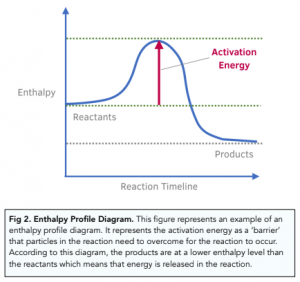
Unsuccessful Collisions
As we learnt above, a collision may not lead to a reaction if the particles do not collide with enough energy or in the correct orientation – this is what we call an unsuccessful collision. If this happens, a repulsion takes place between the particles. Instead of a reaction being initiated between the particles, the species simply bounce off each other.
Rate of Reaction
Defining Rate of Reaction
The rate of reaction is the change in the amount or concentration of a reactant or product over time. It can also be defined by the formula below:

In effect, the rate of reaction is the speed at which reactants get used up and react, or products start to form.
Measuring Rate of Reaction
If a graph is plotted with amount of reactant or product on the y axis against time on the x axis, the gradient of the resulting line can be used as a measure of the rate of the reaction.
Gradient can be calculated using the following equation:

If the graph takes the shape of a curved line, it means that the rate of the reaction changed over time.
In order to calculate the rate of the reaction at a particular point in time, you just have to draw a tangent to the curve at that point and calculate the gradient of said tangent
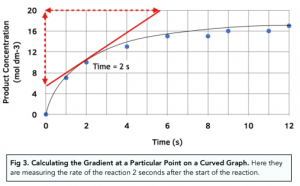
The initial rate of a reaction is the rate at the very start of a reaction when no product has been used up. This can be calculated by finding the gradient of the tangent to the graph at time = 0.
Factors Affecting Rate of Reaction
The rate of reaction is influenced by many factors, including:
- Temperature
- Concentration
- Pressure
- Surface Area
- Presence of Catalysts / Enzymes
In this tutorial we will focus on temperature, concentration, pressure and surface area.
Temperature and Rate of Reaction
Qualitative Effect of Temperature Changes
You should be able to explain the qualitative effect of a change of temperature on the rate of reaction:
- An increase in temperature causes particles in a reaction to move faster as they gain more kinetic energy. The average speed of the particles increases.
- As the particles gain more kinetic energy, a greater proportion of these particles have energy more than the activation energy. In other words, the particles possess at least the activation energy which means they are able to react.
- There is an increase in the number of successful collisions, therefore the rate of reaction increases.

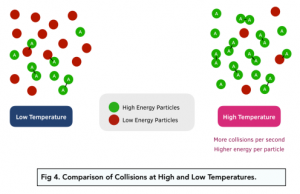
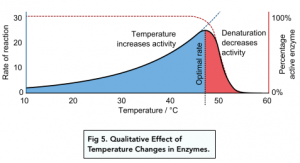
Concentration and Rate of Reaction
Reactions in Solution
You should be able to explain the qualitative effect of a change of concentration on the rate of reaction that takes place in solution:
- An increase in concentration of a solution increases the number of particles within a fixed volume. This means the particles are packed closer together in the reaction and the distance between them is small.
- As there is a smaller distance between the particles, they collide more frequently.
- There is an increase in the rate of reaction as there is an increase in the number of successful collisions.
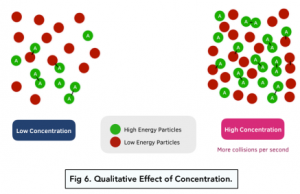
Pressure and Rate of Reaction
Reactions in Gaseous Conditions
You should be able to explain the qualitative effect of a change of pressure on the rate of reaction that takes place in gaseous conditions:
- An increase in pressure of a gas increases the number of particles within a fixed volume. This means the particles are packed closer together in the reaction and the distance between them is small.
- As there is a smaller distance between the particles, they collide more frequently.
- There is an increase in the rate of reaction as there is an increase in the number of successful collisions.
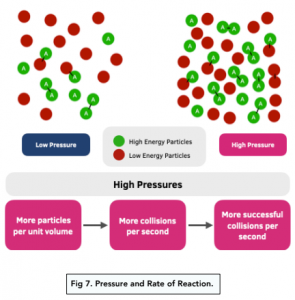
Surface Area and Rate of Reaction
You should be able to explain the qualitative effect of a change of surface are of solid reactants on the rate of reaction:
- Increasing surface area of reactants increases the surface that is exposed to other particles and hence to possible collisions.
- The number of collisions that can take place at any one time increases.
- Therefore, increasing the surface area of a solid reactant increases the rate of the reaction.
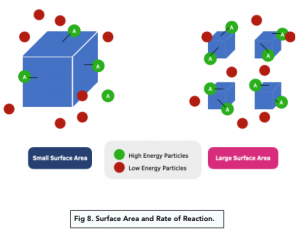
The collision theory is a theory in chemistry that explains how chemical reactions occur at the molecular level. It states that for a reaction to occur, the reacting molecules must collide with enough energy to overcome the activation energy barrier and form new chemical bonds. The theory predicts that the rate of a reaction will depend on the frequency and energy of these collisions.
Activation energy is the minimum energy required for a chemical reaction to occur. It is the energy needed to break the existing bonds in the reactants and form new bonds in the products. In order for a reaction to occur, the colliding molecules must have enough energy to overcome the activation energy barrier.
The temperature of a reaction has a significant impact on its reaction rate. As temperature increases, the average kinetic energy of the colliding molecules also increases. This means that they are more likely to collide with enough energy to overcome the activation energy barrier and react. As a result, increasing the temperature of a reaction will generally lead to an increase in its reaction rate.
The reaction rate can be influenced by a number of factors, including: temperature, concentration of reactants, presence of catalysts, surface area of reactants, and light. By changing these factors, the rate of a reaction can be increased or decreased.
A catalyst is a substance that speeds up the rate of a chemical reaction without being consumed by the reaction. Catalysts work by providing an alternative, lower-energy pathway for the reaction to occur. This reduces the activation energy barrier and allows the reaction to occur more frequently and at a faster rate.
The concentration of the reactants in a reaction has a significant impact on its reaction rate. Increasing the concentration of reactants increases the number of collisions between them and, as a result, the reaction rate. This relationship is often described by the rate law, which states that the rate of a reaction is directly proportional to the concentration of the reactants.
The rate law is an equation that describes the relationship between the reaction rate and the concentration of the reactants. It states that the rate of a reaction is directly proportional to the concentration of the reactants raised to some power, which is determined by the reaction’s rate-determining step. The rate law can be used to determine the order of a reaction and to predict how the reaction rate will change with changes in concentration.






Still got a question? Leave a comment
Leave a comment